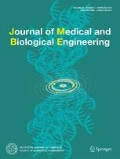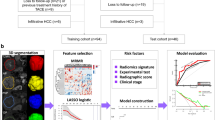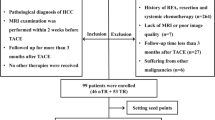Abstract
Purpose
To evaluate the efficiency of an integrated model on MRI scans of hepatocellular carcinoma (HCC) patients for preoperative prediction of transcatheter arterial chemoembolization (TACE) treatment response.
Methods
Radiomics and deep learning features were integrated to build a prediction model for preoperative procedures so as to obtain a fast and accurate prediction of TACE treatment response. This is a retrospective study and the data consists of 71 HCC patients who underwent TACE treatment in a single center. These patients were divided into two groups: progressive disease (PD) response (20 patients) and non-progressive disease (N-PD) response (51 patients). fivefold cross-validation was applied to the data set to validate model performance. A receiver operating characteristic (ROC) curve was used to assess the predictive ability of the model. Quantification of its results was performed by calculating the area under the receiver operating characteristic curve (AUC). The accuracy, recall, specificity, precision and f1_score were also calculated for the cutoff value that maximized the AUC value.
Results
As assessed by the fivefold cross-validation, the integrated model had the best prediction ability, with a value of AUC 0.947 ± 0.069, an accuracy of 0.893 ± 0.088, f1-score of 0.700 ± 0.245, specificity of 0.700 ± 0.245, precision of 0.700 ± 0.245 and a recall of 0.600 ± 0.279. This was followed by the deep learning-based model with an AUC of 0.867 ± 0.121 and the radiomics-based model with an AUC of 0.848 ± 0.128.
Conclusion
The experiment results demonstrate that a feature set that combines radiomics and deep learning features tends to be effective in predicting TACE treatment response as opposed to using only one feature. However, due to the limited amount of data, more data will be needed to verify the effectiveness of this method in the future.






Similar content being viewed by others
References
Ozakyol, A. (2017). Global epidemiology of hepatocellular carcinoma (HCC epidemiology). Journal of gastrointestinal cancer, 48(3), 238–240.
Sung, H., Ferlay, J., Siegel, R. L., Laversanne, M., Soerjomataram, I., Jemal, A., & Bray, F. (2021). Global cancer statistics 2020: GLOBOCAN estimates of incidence and mortality worldwide for 36 cancers in 185 countries. CA: A Cancer Journal for Clinicians, 71(3), 209–249.
Yang, J., Dvornek, N. C.,, Zhang, F., Chapiro, J., Lin, M., Abajian, A., Duncan, J. S. (2019). Hepatocellular carcinoma intra-arterial treatment response prediction for improved therapeutic decision-making. arXiv preprint arXiv:1912.00411.
Piasecki, P., Wierzbicki, M., Majewska, A., Kieda, C., & Narloch, J. (2021). Initial experience with novel Embocure Plus microspheres for transarterial chemoembolization (TACE) of liver metastatic colorectal cancer tumours–a clinical and in vitro study. Polish Journal of Radiology, 86, 136.
Heimbach, J. K., Kulik, L. M., Finn, R. S., Sirlin, C. B., Abecassis, M. M., Roberts, L. R., Zhu, A. X., Hassan Murad, M., & Marrero, J. A. (2018). AASLD guidelines for the treatment of hepatocellular carcinoma. Hepatology, 67(1), 358–380.
Wang, Q., Xia, D., Bai, W., Wang, E., Sun, J., Huang, M., Mu, W., et al. (2019). Development of a prognostic score for recommended TACE candidates with hepatocellular carcinoma: a multicentre observational study. Journal of Hepatology, 70(5), 893–903.
Huang, F., Gong, H., & Xiong, Z. (2018). The safety and efficacy of raltitrexed combined with oxaliplatin in TACE treatment for BCLC B/C hepatocellular carcinomas. Journal of Interventional Radiology, 27(1), 76–79.
Wang, J., Zhong, X., Zhang, Y., Wu, X., Li, S., Jian, P., Ling, Y., et al. (2017). Cezanne predicts progression and adjuvant TACE response in hepatocellular carcinoma. Cell Death & Disease, 8(9), 3043–3043.
Cheng, A. L., Amarapurkar, D., Chao, Y., Chen, P.-J., Geschwind, J.-F., Goh, K. L., Han, K.-H., et al. (2014). Re-evaluating transarterial chemoembolization for the treatment of Hepatocellular Carcinoma: Consensus recommendations and review by an International Expert Panel. Liver International, 34(2), 174–183.
Lencioni, R., de Baere, T., Soulen, M. C., Rilling, W. S., & Geschwind, J.-F.H. (2016). Lipiodol transarterial chemoembolization for hepatocellular carcinoma: a systematic review of efficacy and safety data. Hepatology, 64(1), 106–116.
Guan, Y.-S., He, Q., & Wang, M.-Q. (2012). Transcatheter arterial chemoembolization: history for more than 30 years. International Scholarly Research Notices, 2012, 1–8.
Fohlen, A., Tasu, J. P., Kobeiter, H., Bartoli, J. M., Pelage, J. P., & Guiu, B. (2018). Transarterial chemoembolization (TACE) in the management of hepatocellular carcinoma: Results of a French national survey on current practices. Diagnostic and interventional imaging, 99(9), 527–535.
Xu, X., Gao, D., Yuan, X., Liu, L. I., Zhang, X., Liang, X., Chen, S., et al. (2019). β-Catenin expression correlates with prognosis in hepatocellular carcinoma patients treated with transcatheter arterial chemoembolization. Anticancer Research, 39(3), 1129–1134.
Li, Z., Xiao, Du., Li, X., Zhan, P., Wang, J., & Zhang, H. (2019). Early recurrence detected in hepatocellular carcinoma patients after transcatheter arterial chemoembolization treatment with plasma cell-free DNA. European Journal of Gastroenterology & Hepatology, 31(7), 885–892.
Moon, S. H., Kim, J., Joung, J.-G., Cha, H., Park, W.-Y., Seok Ahn, J., Ahn, M.-J., et al. (2019). Correlations between metabolic texture features, genetic heterogeneity, and mutation burden in patients with lung cancer. European Journal of Nuclear Medicine and Molecular Imaging, 46(2), 446–454.
Tomaszewski, M. R., & Gillies, R. J. (2021). The biological meaning of radiomic features. Radiology, 298, 202553.
Li, Y., Liu, X., Kaibin, Xu., Qian, Z., Wang, K., Fan, X., Li, S., Wang, Y., & Jiang, T. (2018). MRI features can predict EGFR expression in lower grade gliomas: A voxel-based radiomic analysis. European Radiology, 28(1), 356–362.
Goyen, M. (2014). Radiogenomic imaging-linking diagnostic imaging and molecular diagnostics. World Journal of Radiology, 6(8), 519.
Wu, M., Tan, H., Gao, F., Hai, J., Ning, P., Chen, J., Zhu, S., Wang, M., Dou, S., & Shi, D. (2019). Predicting the grade of hepatocellular carcinoma based on non-contrast-enhanced MRI radiomics signature. European Radiology, 29(6), 2802–2811.
Zhang, W., Huang, Z., Zhao, J., He, D., Li, M., Yin, H., Tian, S., Zhang, H., & Song, B. (2021). Development and validation of magnetic resonance imaging-based radiomics models for preoperative prediction of microsatellite instability in rectal cancer. Annals of Translational Medicine, 9(2), 134.
Li, X., Jin, J., Yu, Y., Wang, X., Guo, Y., & Sun, H. (2021). PET-CT radiomics by integrating primary tumor and peritumoral areas predicts E-cadherin expression and correlates with pelvic lymph node metastasis in early-stage cervical cancer. European Radiology, 31, 1–13.
Wang, X.-H., Long, L.-H., Cui, Y., Jia, A. Y., Zhu, X.-G., Wang, H.-Z., Wang, Z., Zhan, C.-M., Wang, Z.-H., & Wang, W.-H. (2020). Mri-Based radiomics model for preoperative prediction of 5-year survival in patients with hepatocellular carcinoma. British Journal of Cancer, 122(7), 978–985.
Valentinuzzi, D., Vrankar, M., Boc, N., Ahac, V., Zupancic, Z., Unk, M., Skalic, K., et al. (2020). [18F] FDG PET immunotherapy radiomics signature (iRADIOMICS) predicts response of non-small-cell lung cancer patients treated with pembrolizumab. Radiology and Oncology, 54(3), 285.
Haider, S. P., Burtness, B., Yarbrough, W. G., & Payabvash, S. (2020). Applications of radiomics in precision diagnosis, prognostication and treatment planning of head and neck squamous cell carcinomas. Cancers of the Head & Neck, 5, 1–19.
Wang, J., Zheng, X., Zhang, J., Xue, H., Wang, L., Jing, R., Chen, S., et al. (2021). An MRI-based radiomics signature as a pretreatment noninvasive predictor of overall survival and chemotherapeutic benefits in lower-grade gliomas. European Radiology, 31(4), 1785–1794.
Tustison, N. J., Avants, B. B., Cook, P. A., Zheng, Y., Egan, A., Yushkevich, P. A., & Gee, J. C. (2010). N4ITK: Improved N3 bias correction. IEEE Transactions on Medical Imaging, 29(6), 1310–1320.
Nyúl, L. G., Udupa, J. K., & Zhang, X. (2000). New variants of a method of MRI scale standardization. IEEE Transactions on Medical Imaging, 19(2), 143–150.
Van Griethuysen, J. J. M., Fedorov, A., Parmar, C., Hosny, A., Aucoin, N., Narayan, V., Beets-Tan, R. G. H., Fillion-Robin, J.-C., Pieper, S., & Aerts, H. J. W. L. (2017). Computational radiomics system to decode the radiographic phenotype. Cancer Research, 77(21), e104–e107.
Agarap, A. F. (2018). Deep learning using rectified linear units (relu)." arXiv preprint arXiv:1803.08375.
Abadi, M., Barham, P., Chen, J., Chen, Z., Davis, A., Dean, J., Devin, M., et al. (2016). Tensorflow: A system for large-scale machine learning. In 12th {USENIX} symposium on operating systems design and implementation ({OSDI} 16), pp. 265–283.
Kingma, D. P., & Ba, J. (2014). Adam: A method for stochastic optimization. arXiv preprint arXiv:1412.6980.
Benesty, J., Chen, J., Huang, Y., & Cohen, I. (2009). Pearson correlation coefficient. In I. Cohen (Ed.), Noise Reduction in Speech Processing (pp. 1–4). Berlin: Springer.
Fehr, D., Veeraraghavan, H., Wibmer, A., Gondo, T., Matsumoto, K., Alberto Vargas, H., Sala, E., Hricak, H., & Deasy, J. O. (2015). Automatic classification of prostate cancer Gleason scores from multiparametric magnetic resonance images. Proceedings of the National Academy of Sciences, 112(46), 6265–6273.
Larroza, A., Moratal, D., Paredes-Sánchez, A., Soria-Olivas, E., Chust, M. L., Arribas, L. A., & Arana, E. (2015). Support vector machine classification of brain metastasis and radiation necrosis based on texture analysis in MRI. Journal of Magnetic Resonance Imaging, 42(5), 1362–1368.
Wei, X., Ai, J., Deng, Y., Guan, X., Johnson, D. R., Ang, C. Y., Zhang, C., & Perkins, E. J. (2014). Identification of biomarkers that distinguish chemical contaminants based on gene expression profiles. BMC Genomics, 15(1), 1–17.
Ota, K., Oishi, N., Ito, K., Fukuyama, H., Sead-J Study Group. (2014). A comparison of three brain atlases for MCI prediction. Journal of Neuroscience Methods, 221, 139–150.
Chang, Y.-W., Lin, C.-J. (2008). Feature ranking using linear SVM. In Causation and prediction challenge, pp. 53–64. PMLR.
Mladenić, D., Brank, J., Grobelnik, M., Milic-Frayling, N. (2004). Feature selection using linear classifier weights: interaction with classification models. In Proceedings of the 27th annual international ACM SIGIR conference on Research and development in information retrieval, pp. 234–241.
Chawla, N. V., et al. (2002). SMOTE: synthetic minority over-sampling technique. Journal of Artificial Intelligence Research, 16, 321–357.
Wang, C.-W., et al. (2018). JOURNAL CLUB: The Warthin tumor score: a simple and reliable method to distinguish Warthin tumors from pleomorphic adenomas and carcinomas. American Journal of Roentgenology, 210, 1330–1337.
Zhang, Y.-Q., Jiang, L.-J., Wen, J., Liu, D.-M., Gui-Hua Huang, Yu., Wang, W.-Z., & Li, J.-P. (2018). Comparison of α-fetoprotein criteria and modified response evaluation criteria in solid tumors for the prediction of overall survival of patients with hepatocellular carcinoma after transarterial chemoembolization. Journal of Vascular and Interventional Radiology, 29(12), 1654–1661.
Zinn, P. O., Singh, S. K., Kotrotsou, A., Zandi, F., Thomas, G., Hatami, M., Luedi, M. M., et al. (2016). 139 Clinically applicable and biologically validated MRI radiomic test method predicts glioblastoma genomic landscape and survival. Neurosurgery, 63(1), 156–157.
Choi, S. W., Cho, H.-H., Koo, H., Rae Cho, K., Nenning, K.-H., Langs, G., Furtner, J., et al. (2020). Multi-habitat radiomics unravels distinct phenotypic subtypes of glioblastoma with clinical and genomic significance. Cancers, 12(7), 1707.
Capobianco, E., & Dominietto, M. (2020). From medical imaging to radiomics: Role of data science for advancing precision health. Journal of personalized medicine, 10(1), 15.
Kim, J., Joon Choi, S., Lee, S.-H., Lee, H. Y., & Park, H. (2018). Predicting survival using pretreatment CT for patients with hepatocellular carcinoma treated with transarterial chemoembolization: comparison of models using radiomics. American Journal of Roentgenology, 211, 1026–1034.
Grossmann, P., Stringfield, O., El-Hachem, N., Bui, M. M., Rios Velazquez, E., Parmar, C., Leijenaar, R. T. H., et al. (2017). Defining the biological basis of radiomic phenotypes in lung cancer. Elife, 6, e23421.
Jeong, W. K., Jamshidi, N., Felker, E. R., Raman, S. S., & Shinkuo Lu, D. (2019). Radiomics and radiogenomics of primary liver cancers. Clinical and Molecular Hepatology, 25(1), 21.
Wu, W., Parmar, C., Grossmann, P., Quackenbush, J., Lambin, P., Bussink, J., Mak, R., & Aerts, H. J. W. L. (2016). Exploratory study to identify radiomics classifiers for lung cancer histology. Frontiers in Oncology, 6, 71.
Mumtaz, W., Xia, L., Azhar Mohd Yasin, M., Azhar Ali, S. S., & Saeed Malik, A. (2017). A wavelet-based technique to predict treatment outcome for major depressive disorder. PLoS ONE, 12(2), e0171409.
Huang, Y., Liu, Z., He, L., Chen, X., Pan, D., Ma, Z., Liang, C., Tian, J., & Liang, C. (2016). Radiomics signature: A potential biomarker for the prediction of disease-free survival in early-stage (I or II) non—small cell lung cancer. Radiology, 281(3), 947–957.
Chicklore, S., Goh, V., Siddique, M., Roy, A., Marsden, P. K., & Cook, G. J. R. (2013). Quantifying tumour heterogeneity in 18 F-FDG PET/CT imaging by texture analysis. European Journal of Nuclear Medicine and Molecular Imaging, 40(1), 133–140.
Cook, G. J. R., Yip, C., Siddique, M., Goh, V., Chicklore, S., Roy, A., Marsden, P., Ahmad, S., & Landau, D. (2013). Are pretreatment 18F-FDG PET tumor textural features in non–small cell lung cancer associated with response and survival after chemoradiotherapy? Journal of Nuclear Medicine, 54(1), 19–26.
Mahmood, U., Apte, A., Deasy, J. O., Schmidtlein, C. R., & Shukla-Dave, A. (2017). Investigating the robustness Neighborhood Grey Tone Difference Matrix (NGTDM) and Grey Level Co-Occurrence Matrix (GLCM) radiomic features on clinical Computed Tomography systems using Anthropomorphic Phantoms: Evidence from a multivendor study. Journal of Computer Assisted Tomography, 41(6), 995.
Ekert, K., Hinterleitner, C., & Horger, M. (2019). Prognosis assessment in metastatic gastrointestinal stromal tumors treated with tyrosine kinase inhibitors based on CT-texture analysis. European journal of radiology, 116, 98–105.
Thibault, G., Fertil, B., Navarro, C., Pereira, S., Cau, P., Levy, N., Sequeira, J., & Mari, J.-L. (2013). Shape and texture indexes application to cell nuclei classification. International Journal of Pattern Recognition and Artificial Intelligence, 27(01), 1357002.
Duron, L., Balvay, D., Vande Perre, S., Bouchouicha, A., Savatovsky, J., Sadik, J.-C., Thomassin-Naggara, I., Fournier, L., & Lecler, A. (2019). Gray-level discretization impacts reproducible MRI radiomics texture features. PLoS ONE, 14(3), e0213459.
Buvat, I., Orlhac, F., & Soussan, M. (2015). Tumor texture analysis in PET: Where do we stand? Journal of Nuclear Medicine, 56(11), 1642–1644.
Ekert, K., Hinterleitner, C., Baumgartner, K., Fritz, J., & Horger, M. (2020). Extended texture analysis of non-enhanced whole-body MRI image data for response assessment in multiple myeloma patients undergoing systemic therapy. Cancers, 12(3), 76.
Funding
This work was supported by the Integrated Medicine and Engineering Research Project of Fudan University [Grant Numbers yg2021–020].
Author information
Authors and Affiliations
Corresponding authors
Ethics declarations
Conflict of interest
The author(s) declared no potential conflicts of interest with respect to the research, authorship, and/or publication of this article.
Rights and permissions
About this article
Cite this article
Tian, Y., Komolafe, T.E., Chen, T. et al. Prediction of TACE Treatment Response in a Preoperative MRI via Analysis of Integrating Deep Learning and Radiomics Features. J. Med. Biol. Eng. 42, 169–178 (2022). https://doi.org/10.1007/s40846-022-00692-w
Received:
Accepted:
Published:
Issue Date:
DOI: https://doi.org/10.1007/s40846-022-00692-w




